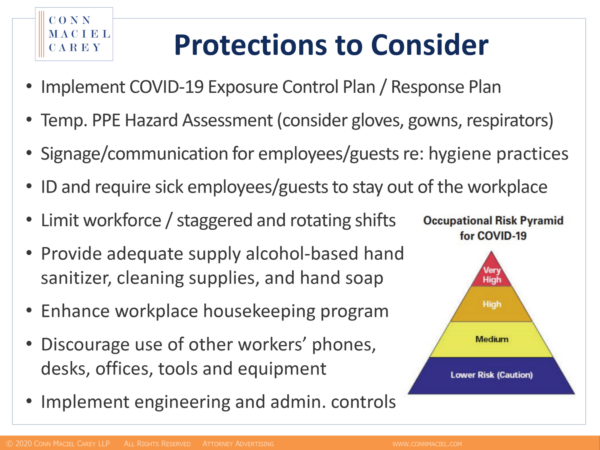A free webinar, “COVID-19 Updates for Grain, Feed and Processing Industry: OSHA Guidance and Workplace Health and Safety Issues," was hosted on May 20 by the National Grain and Feed Association and Grain Journal magazine. The webinar was presented by Eric J. Conn, a founding partner of Conn Maciel Carey, LLP and Chair of the firm’s national OSHA Workplace Safety Group. The following information is directly from Conn's presentation.
Develop an Exposure Response Plan
What types of protective measures should employers implement in response to the COVID-19 pandemic?
The slide above illustrates examples of the different types of engineering controls, workplace administrative policies, and protective equipment guidelines that the Occupational Safety and Health Administration (OSHA) and Centers for Disease Control and Prevention (CDC) recommend to businesses and employers.
Of course, the degree to which these are implemented will rely heavily on where an employer sits on OSHA’s occupational risk pyramid for COVID-19, which breaks up exposure risk levels into four categories: very high, high, medium, and lower risk, as well as the nature of the spread of the virus in the community where the workplace is located.
Importantly, what OSHA and the CDC have been very clear on all along, is that all employers, no matter where they sit on the risk pyramid, should develop a comprehensive, written COVID-19 Exposure Control and Response Plan. These plans should be developed and implemented for any workplace where workers will be present (i.e., any that will not be 100 percent telework throughout the pandemic).
There are many reasons why it is important to develop an Exposure Control Plan as a single, coherent written document.
First and foremost, having a written plan communicates to employees that their employers are taking the pandemic seriously, and doing everything they can to protect their workforce. Understandably, just as the general public is, employees are concerned about their safety. Indeed, OSHA has received thousands of COVID-19-related health and safety complaints from employees against their employers.
A thorough, well-written exposure control plan can provide comfort to employees, letting them know that this hazard is being taken seriously, and that considerable thought has been put into their well-being. That will reduce the likelihood of employees refusing to come to work and/or filing complaint with OSHA, which could result in retaliation claims and/or OSHA enforcement inspections.
Additionally, employers who have a written exposure control plan in place will have a much easier time responding to OSHA should OSHA open an investigation (such as after an employee complaint or a reported in-patient hospitalization or fatality). Demonstrating to OSHA that you have a robust exposure control plan, which documents all of the protective measures you have implemented in response to the pandemic to keep your employees safe, is a critical defense.
Finally, there will undoubtedly be a flood of litigation around the country related to COVID-19 – from claims concerning employment and employee or third party wrongful death or personal injury suits associated with COVID-19 infections purportedly contracted in your workplace. Having an effective, coherent written exposure control plan will be an essential defense to those lawsuits.
Conn Maciel Carey has been working with employers across all industries to develop custom, compliant Exposure Control and Response Plans.
Click here to read the OSHA guidance → Guidance on Preparing Workplaces for COVID-19
Click here to view the full recorded webinar → OSHA Guidance and Workplace Health and Safety Issues
Click here to view COVID-19 Resources prepared by Conn Maciel Carey's COVID-19 Task Force


